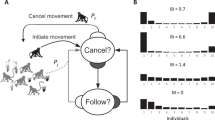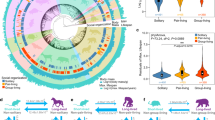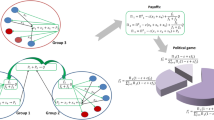Abstract
Living systems sometimes experience abrupt tipping points in response to stress. Here we investigate the factors contributing to the appearance of such abrupt state transitions in animal societies. We first construct a mathematical account of how the personality compositions of societies could alter their propensity to shift from calm to violent states in response to thermal stress. To evaluate our model, we subjected experimental societies of the spider Anelosimus studiosus to heat stress. We demonstrate that both colony size and personality composition influence the timing of and recoverability from sudden transitions in social state. Groups composed of aggressive personalities transitioned into violent within-group dynamics sooner during heating, and also resisted recovery to baseline non-aggressive behaviour during cooling. We further observed hysteresis in groups composed of aggressive individuals, where group behaviour depended strongly on whether the colony had previously been in a calm or agitated state. These results demonstrate that a society’s susceptibility to sudden state shifts and their recoverability from them can be driven by the personalities of their constituents.
This is a preview of subscription content, access via your institution
Access options
Access Nature and 54 other Nature Portfolio journals
Get Nature+, our best-value online-access subscription
$29.99 / 30 days
cancel any time
Subscribe to this journal
Receive 12 digital issues and online access to articles
$119.00 per year
only $9.92 per issue
Buy this article
- Purchase on Springer Link
- Instant access to full article PDF
Prices may be subject to local taxes which are calculated during checkout




Similar content being viewed by others
References
Flack, J. C., Girvan, M., de Waal, F. B. M. & Krakauer, D. C. Policing stabilizes construction of social niches in primates. Nature 439, 426–429 (2006).
Flack, J. C., Krakauer, D. C. & de Waal, F. B. M. Robustness mechanisms in primate societies: a perturbation study. Proc. R. Soc. B 272, 1091–1099 (2005).
Scheffer, M. Critical Transitions in Nature and Society (Princeton Univ. Press, Princeton, 2009).
Scheffer, M. et al. Anticipating critical transitions. Science 338, 344–348 (2012).
Dai, L., Korolev, K. S. & Gore, J. Slower recovery in space before collapse of connected populations. Nature 496, 355–358 (2013).
Carpenter, S. R., Westley, F. & Turner, M. G. Surrogates for resilience of social–ecological systems. Ecosystems 8, 941–944 (2005).
Amable, B., Henry, J., Lordon, F. & Topol, R. Strong hysteresis versus zero-root dynamics. Econ. Lett. 44, 43–47 (1994).
Roy, S. B., Chaddah, P. & Chaudhary, S. The anomalous mixed state of the C15-Laves phase superconductor CeRu2: II. History dependence in field-cooled magnetization hysteresis. J. Phys. Condens. Matter 10, 8327 (1998).
Gutschick Vincent, P. & BassiriRad, H. Extreme events as shaping physiology, ecology, and evolution of plants: toward a unified definition and evaluation of their consequences. New Phytol. 160, 21–42 (2003).
Golden, J. S., Guthrie, P. M., Kaloush, K. E. & Britter, R. E. Summertime urban heat island hysteresis lag complexity. Proc. Inst. Civil. Eng. Eng. Sustain. 158, 197–210 (2005).
Tarnita, C. E. et al. A theoretical foundation for multi-scale regular vegetation patterns. Nature 541, 398–401 (2017).
Norström, A. V., Nyström, M., Lokrantz, J. & Folke, C. Alternative states on coral reefs: beyond coral-macroalgal phase shifts. Mar. Ecol. Prog. Ser. 376, 295–306 (2009).
Mumby, P. J., Steneck, R. S. & Hastings, A. Evidence for and against the existence of alternate attractors on coral reefs. Oikos 122, 481–491 (2013).
Genton, C. et al. How Ebola impacts social dynamics in gorillas: a multistate modelling approach. J. Anim. Ecol. 84, 166–176 (2015).
Seeley, T. D. & Buhrman, S. C. Group decision making in swarms of honey bees. Behav. Ecol. Sociobiol. 45, 19–31 (1999).
Pratt, S. C., Mallon, E. B., Sumpter, D. J. T. & Franks, N. R. Quorum sensing, recruitment, and collective decision-making during colony emigration by the ant Leptothorax albipennis. Behav. Ecol. Sociobiol. 52, 117–127 (2002).
Nieh, J. C., Barreto, L. S., Contrera, F. A. L. & Imperatriz-Fonseca, V. L. Olfactory eavesdropping by a competitively foraging stingless bee, Trigona spinipes. Proc. R. Soc. B 271, 1633–1640 (2004).
Dall, S. R. X., Houston, A. I. & McNamara, J. M. The behavioural ecology of personality: consistent individual differences from an adaptive perspective. Ecol. Lett. 7, 734–739 (2004).
Oster, G. F. & Wilson, E. O. Caste and Ecology in the Social Insects (Princeton Univ. Press, Princeton, 1978).
Beshers, S. N. & Fewell, J. H. Models of division of labor in social insects. Annu. Rev. Entomol. 46, 413–440 (2001).
Fogarty, S., Cote, J. & Sih, A. Social personality polymorphism and the spread of invasive species: a model. Am. Nat. 177, 273–287 (2011).
Hui, A. & Pinter-Wollman, N. Individual variation in exploratory behaviour improves speed and accuracy of collective nest selection by Argentine ants. Anim. Behav. 93, 261–266 (2014).
O’Shea-Wheller, T. A., Masuda, N., Sendova-Franks, A. B. & Franks, N. R. Variability in individual assessment behaviour and its implications for collective decision-making. Proc. R. Soc. B 284, 20162237 (2017).
Jolles, J. W., Boogert, N. J., Sridhar, V. H., Couzin, I. D. & Manica, A. Consistent individual differences drive collective behavior and group functioning of schooling fish. Curr. Biol. 27, 2862–2868.e7 (2017).
McCreery, H. F. A comparative approach to cooperative transport in ants: individual persistence correlates with group coordination. Insect Soc. 64, 535–547 (2017).
Paleolog, J. Behavioural characteristics of honey bee (Apis mellifera) colonies containing mix of workers of divergent behavioural traits. Anim. Sci. Pap. Rep. 27, 237–248 (2009).
Pruitt, J. N. A real-time eco-evolutionary dead-end strategy is mediated by the traits of lineage progenitors and interactions with colony invaders. Ecol. Lett. 16, 879–886 (2013).
Pruitt, J. N. & Goodnight, C. J. Site-specific group selection drives locally adapted group compositions. Nature 514, 359–362 (2014).
Pruitt, J. N. & Modlmeier, A. P. Animal personality in a foundation species drives community divergence and collapse in the wild. J. Anim. Ecol. 84, 1461–1468 (2015).
Riechert, S. E. & Jones, T. C. Phenotypic variation in the social behaviour of the spider Anelosimus studiosus along a latitudinal gradient. Anim. Behav. 75, 1893–1902 (2008).
Pruitt, J. N., Riechert, S. E. & Jones, T. C. Behavioural syndromes and their fitness consequences in a socially polymorphic spider, Anelosimus studiosus. Anim. Behav. 76, 871–879 (2008).
Pruitt, J. N. & Riechert, S. E. Sex matters: sexually dimorphic fitness consequences of a behavioural syndrome. Anim. Behav. 78, 175–181 (2009).
Beekman, M., Sumpter, D. J. T. & Ratnieks, F. L. W. Phase transition between disordered and ordered foraging in Pharaoh’s ants. Proc. Natl Acad. Sci. USA 98, 9703–9706 (2001).
Duncan, S. I., Riechert, S. E., Fitzpatrick, B. M. & Fordyce, J. A. Relatedness and genetic structure in a socially polymorphic population of the spider Anelosimus studiosus. Mol. Ecol. 19, 810–818 (2010).
Furey, R. E. Two cooperatively social populations of the theridiid spider Anelosimus studiosus in a temperate region. Anim. Behav. 55, 727–735 (1998).
Pruitt, J. N. & Riechert, S. E. Frequency-dependent success of cheaters during foraging bouts might limit their spread within colonies of a socially polymorphic spider. Evolution 63, 2966–2973 (2009).
Comparative Climatic Data (National Centers for Environmental Information, accessed 26 November 2017); https://www.ncdc.noaa.gov/ghcn/comparative-climatic-data
Carstensen, J. & Weydmann, A. Tipping points in the Arctic: eyeballing or statistical significance? Ambio 41, 34–43 (2012).
Cavanaugh, K. C. et al. Poleward expansion of mangroves is a threshold response to decreased frequency of extreme cold events. Proc. Natl Acad. Sci. USA 111, 723–727 (2014).
Vanacker, M., Wezel, A., Payet, V. & Robin, J. Determining tipping points in aquatic ecosystems: the case of biodiversity and chlorophyll α relations in fish pond systems. Ecol. Indic. 52, 184–193 (2015).
Keiser Carl, N. et al. The primary case is not enough: variation among individuals, groups and social networks modify bacterial transmission dynamics. J. Anim. Ecol. 87, 369–378 (2017).
McDougall, P. T., Réale, D., Sol, D. & Reader, S. M. Wildlife conservation and animal temperament: causes and consequences of evolutionary change for captive, reintroduced, and wild populations. Anim. Conserv. 9, 39–48 (2006).
Martin-Wintle, M. S. et al. Do opposites attract? Effects of personality matching in breeding pairs of captive giant pandas on reproductive success. Biol. Conserv. 207, 27–37 (2017).
Burns, J. G. & Dyer, A. G. Diversity of speed-accuracy strategies benefits social insects. Curr. Biol. 18, R953–R954 (2008).
Modlmeier, A. P. & Foitzik, S. Productivity increases with variation in aggression among group members in Temnothorax ants. Behav. Ecol. 22, 1026–1032 (2011).
Daniels, B. C., Krakauer, D. C. & Flack, J. C. Control of finite critical behaviour in a small-scale social system. Nat. Commun. 8, 14301 (2017).
Goulet, C. T., Ingley, S. J., Scharf, I. & Pruitt, J. N. Thermal effects on survival and reproductive performance vary according to personality type. Behav. Ecol. 27, 1635–1641 (2016).
Pruitt, J. N. & Avilés, L. Social spiders: mildly successful social animals with much untapped research potential. Anim. Behav. https://doi.org/10.1016/j.anbehav.2017.08.015 (2017).
Pruitt, J. N., Riechert, S. E. & Harris, D. J. Reproductive consequences of male body mass and aggressiveness depend on females’ behavioral types. Behav. Ecol. Sociobiol. 65, 1957–1966 (2011).
Pruitt, J. N., Oufiero, C. E., Avilés, L. & Riechert, S. E. Iterative evolution of increased behavioral variation characterizes the transition to sociality in spiders and proves advantageous. Am. Nat. 180, 496–510 (2012).
Pruitt, J. N., Iturralde, G., Avilés, L. & Riechert, S. E. Amazonian social spiders share similar within-colony behavioural variation and behavioural syndromes. Anim. Behav. 82, 1449–1455 (2011).
Watts, J. C., Ross, C. R. & Jones, T. C. Diel and life-history characteristics of personality: consistency versus flexibility in relation to ecological change. Anim. Behav. 101, 43–49 (2015).
Muggeo, V. M. R. Segmented: an R package to fit regression models with broken-line relationships. R News 8, 20–25 (2008).
Muggeo, V. M. R. Estimating regression models with unknown break-points. Stat. Med. 22, 3055–3071 (2003).
Ferziger, J. H. & Perić, M. Further discussion of numerical errors in CFD. Int. J. Numer. Meth. Fluids 23, 1263–1274 (1996).
Acknowledgements
E. Eliason, H. Young and D. McCauley kindly provided comments on earlier versions of this manuscript. J.N.P. was supported by National Science Foundation (NSF) Division of Integrative Organismal Systems (IOS) grants 1352705 and 1455895. J.N.P. and I.S. were supported by the United States-Israel Binational Science Foundation (BSF) grant 2013086.
Author information
Authors and Affiliations
Contributions
G.N.D., I.S., H.V.M. and J.N.P. contributed to mathematical modelling, statistical analysis, writing and figure production for this manuscript. J.N.P. collected the empirical data.
Corresponding author
Ethics declarations
Competing interests
The authors declare no competing interests.
Additional information
Publisher’s note: Springer Nature remains neutral with regard to jurisdictional claims in published maps and institutional affiliations.
Supplementary information
Supplementary information
Supplementary Text & Statistical Outputs; Supplementary Figures 1–4
Rights and permissions
About this article
Cite this article
Doering, G.N., Scharf, I., Moeller, H.V. et al. Social tipping points in animal societies in response to heat stress. Nat Ecol Evol 2, 1298–1305 (2018). https://doi.org/10.1038/s41559-018-0592-5
Received:
Accepted:
Published:
Issue Date:
DOI: https://doi.org/10.1038/s41559-018-0592-5
This article is cited by
-
Siblicide in the city: the urban heat island accelerates sibling cannibalism in the black widow spider (Latrodectus hesperus)
Urban Ecosystems (2022)
-
Decrease in social cohesion in a colonial seabird under a perturbation regime
Scientific Reports (2020)
-
Population differences in aggression are shaped by tropical cyclone-induced selection
Nature Ecology & Evolution (2019)



